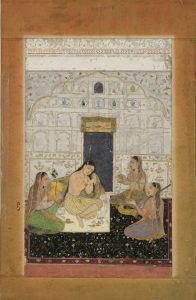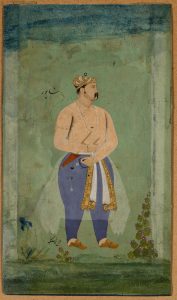Nar Singh. Active 17th Century CE
Indian, Mughal Empire
Portrait of Prince Daniyal (Brother of Emperor Jahangir reigned 1605-1627)
Ink, opaque watercolors, and gold on paper
Gift of Elinor Lander Horwitz, class of 1950
SC 2016:29-5
Portrait of Prince Daniyal is characteristic of imperial portraiture during the Mughal Empire (1526-1857). It features a single figure standing in front of a sparse, naturalistic background.
The artist indicates the royal status of the painting’s subject both by the Persian word for prince, shapur, written in script next to his head, and by the ornate clothing he wears, decorated with intricate gilded geometric designs.
The stand-alone image would most likely have been pasted onto the pages of a muraqqa (album), into which the likenesses of other elites would be assembled. By painting different rulers in an almost identical fashion, the production of imperial albums allowed for the emergence of a distinct style that would in dicate the royal nature of the subject entirely through visual cues.
dicate the royal nature of the subject entirely through visual cues.
The popularity of this format suggests the importance of creating cohesive portrayals of members of the Mughal ruling class.
Adela Goldsmith, Smith College ‘19
India, Mughal Empire. 17th century CE
Princess with Attendants
Ink, opaque watercolors, and gold on paper
Gift of Elinor Lander Horwitz, class of 1950
SC 2016:29-6
Portrait of Prince Daniyal
[Detailed Image Description: The painting is of a single standing figure dressed in a long sheer coat that falls to his knees, wide blue paints. He wears an ornately decorated turban, sash, and shoes. He has delicate features and a mustache and his arms are folded in front of his body. The background of the painting is a light blue-green with a band of dark blue above the figure’s head and a band of dark green with small brushstrokes to evoke grass beneath him. On either side of his feet are delicate plants with blue and purple flowers. There are small floating portions of Arabic script written by the head of the central figure as well as by his feet. The two vertical edges appear more faded than the central portion of the painting.]
Princess with Attendants
[Detailed Image Description: The painting features a central figure and three attending figures are all seated on an ornately decorated floral carpet underneath an arch. All four wear brightly colored dresses/saris in green, yellow, purple and have sheer veils with edges trimmed in gold. The bodies of the three attendants are all turned inward towards the central figure with whom they gesture and converse. The attendant on the far left is helping the central figure into her clothes. The attendant on the far right plays a stringed instrument. Behind the figures is a white wall with gilded architectural detailing and floral designs. There are arched niches in the wall in which there are decorative bottles and jars. The unpainted edges of the picture are brown as a result of the paper aging.]
